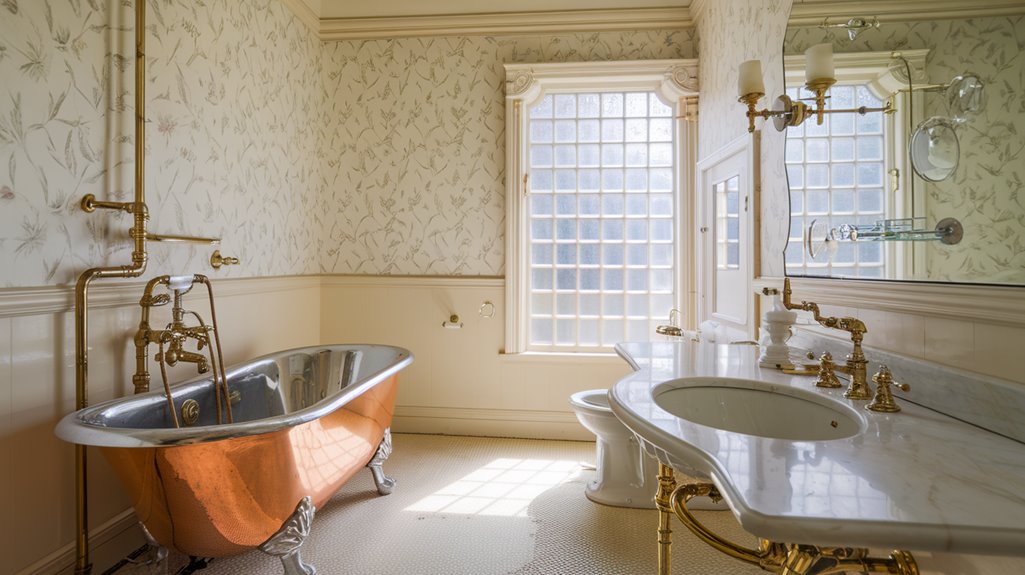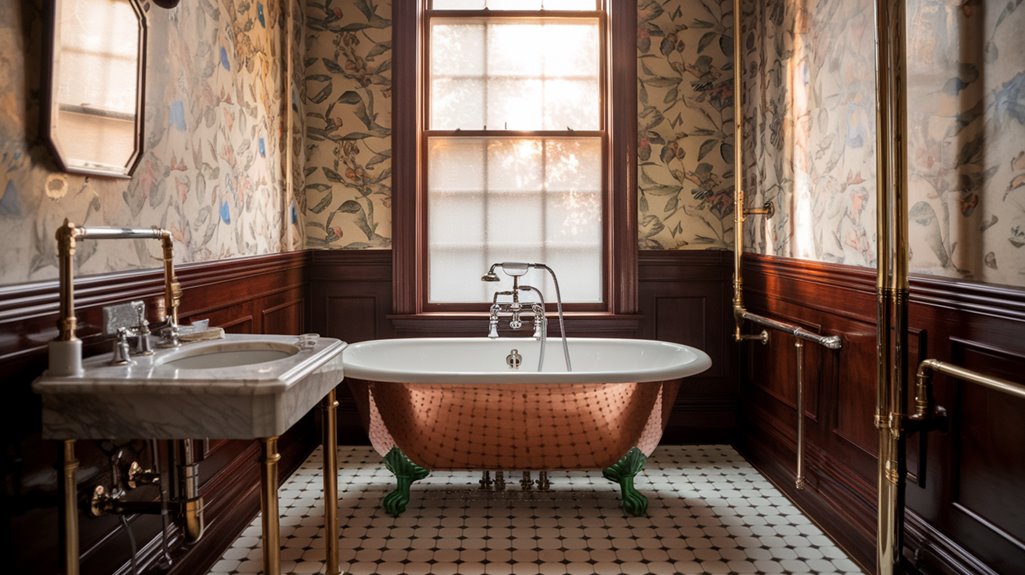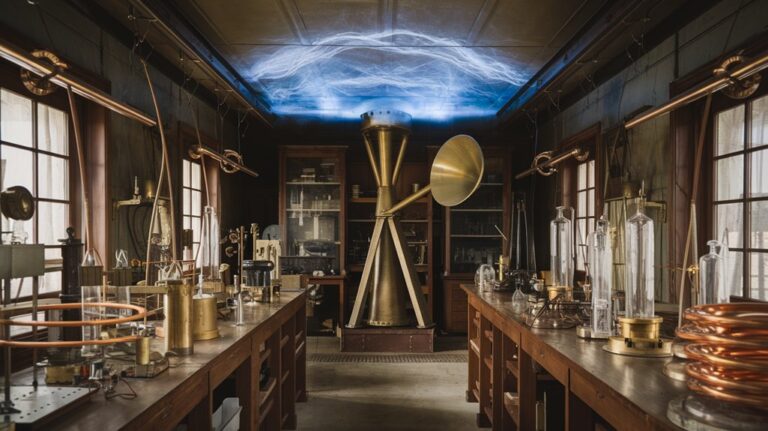Indoor Plumbing Became Common in the 19th Century
Like a river carving its path through untamed wilderness, indoor plumbing transformed the landscape of 19th-century American homes. You might think having a faucet and toilet inside your house is unremarkable today, but this innovation marked a revolutionary change in how people lived. If you'd stepped into a wealthy person's home in 1850, you'd have witnessed the early stages of a comfort revolution that would eventually reshape society's relationship with water and sanitation—though the path to universal access wasn't simple.
The Rise of Indoor Plumbing in Wealthy Homes
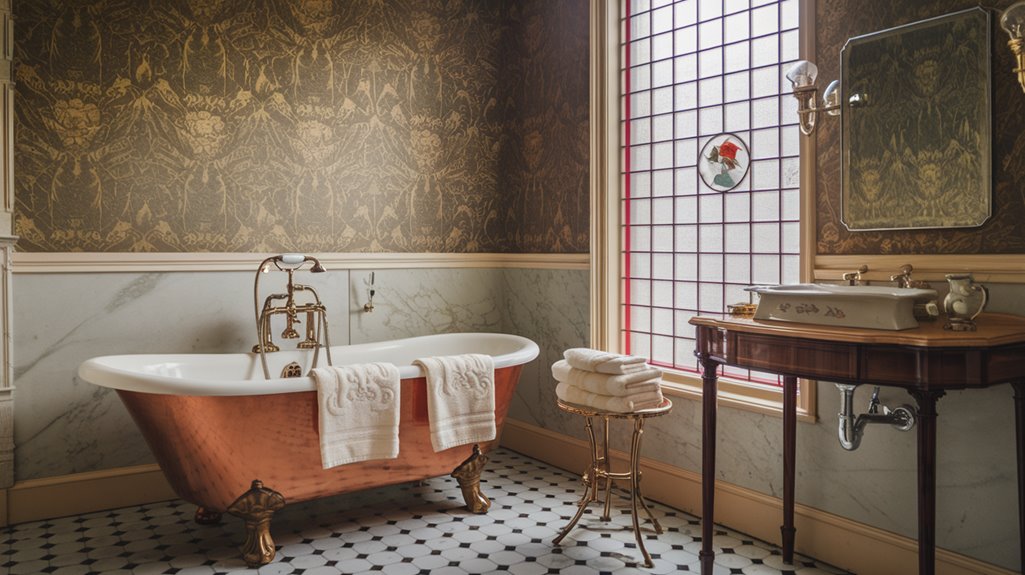
As living standards improved in the mid-19th century, wealthy Americans began transforming their homes with revolutionary indoor plumbing systems.
You'd find luxury bathrooms emerging in these affluent residences, where sinks were initially placed in bedrooms to replace traditional water pitchers and basins.
To maintain plumbing aesthetics and hygiene, homeowners kept bathtubs and toilets in separate rooms to minimize odors and contamination. By the 1880s, these separate facilities were consolidated into what became known as the modern bathroom space. This was a stark contrast to today, where 1.1 million Americans still live without access to running water.
Early Pioneers and Their Groundbreaking Inventions
While indoor plumbing began transforming wealthy homes, several ingenious inventors were laying the groundwork for modern sanitation. It's worth noting that the ancient Romans achieved remarkable feats by delivering 1.2 billion liters of fresh water daily through their aqueduct systems.
Cast iron pipes became the material of choice during this period, offering unprecedented durability for water systems.
You'll find that toilet innovations came from brilliant plumbing pioneers like Alexander Cumming, who revolutionized sanitation with his S-trap design in 1775, preventing sewer gases from entering homes.
Thomas Crapper later made these developments accessible to the public, helping spread indoor plumbing across society.
Key advances that shaped modern plumbing:
- John Harington's first flushing toilet for Queen Elizabeth I (1596)
- Isaiah Rogers' groundbreaking indoor plumbing system at Boston's Tremont Hotel (1829)
- Benjamin Waddy Maughan's instantaneous water heater invention (1868)
These inventions dramatically improved living conditions, setting the stage for the widespread adoption of indoor plumbing we enjoy today.
Public Health Crisis and Urban Sanitation Reform
During the 19th century's explosive urban growth, cities faced an unprecedented public health crisis that would forever change sanitation standards.
The U.S. urban population grew from 1.8 to 54 million between 1840 and 1920.
You'd find horrifying conditions in urban areas, where more than half of London's working-class children died before age five due to diseases like cholera, typhoid, and tuberculosis spreading through filthy streets and contaminated water supplies.
The crisis sparked the Great Sanitary Awakening, leading to essential public health reforms. A devastating cholera epidemic in 1853-54 killed 23,000 people in the UK alone.
You can trace modern sanitation legislation to pioneering reports by Chadwick and Shattuck, who documented the dire conditions and proposed thorough solutions. Their work led to the establishment of health departments and the passage of groundbreaking public health laws, starting with New York's Metropolitan Board of Health.
Though they didn't yet understand germ theory, these reforms dramatically improved urban living conditions.
Technological Breakthroughs in Water Heating Systems
Because the demand for indoor hot water grew rapidly in the late 1800s, inventors made remarkable strides in water heating technology.
Ancient civilizations relied on fire-heated metal vessels to warm their water for daily use.
You'll find that Benjamin Maughan's 1868 "geyser" patent and Edwin Ruud's 1889 automatic storage water heater transformed how people accessed hot water at home.
These innovations led to safer, more reliable systems that you'd recognize in modern homes.
The evolution of water heating systems has given you three major benefits:
- Enhanced energy efficiency through tankless, on-demand heating
- Improved safety features compared to early industrial boilers
- Better integration with modern plumbing infrastructure
Today's water heating technology continues to advance, with a strong focus on environmental responsibility.
You'll find that contemporary systems offer both the convenience of immediate hot water and the advantage of reduced energy consumption.
The Transformation of Urban Infrastructure
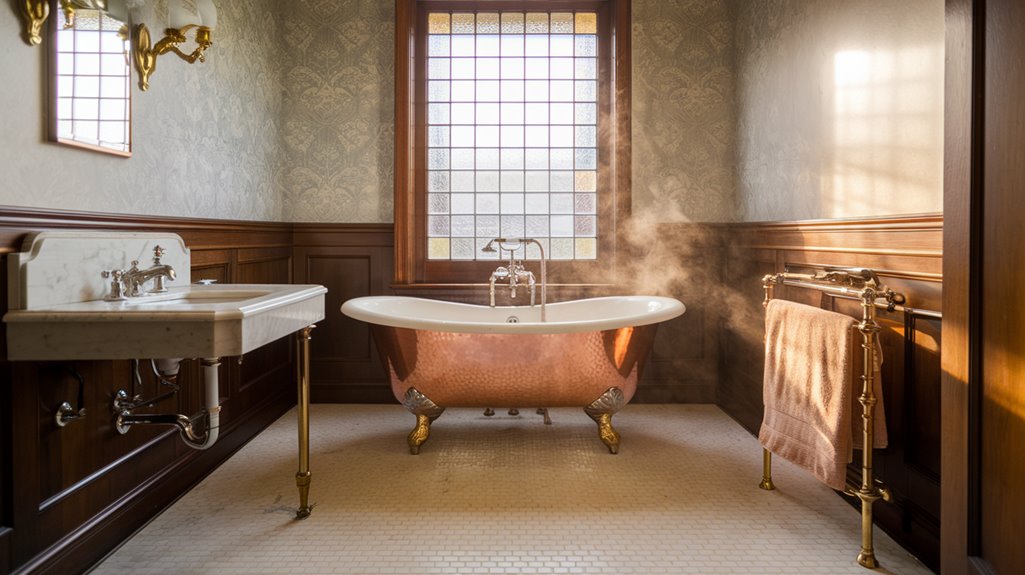
As cities swelled with unprecedented population growth in the 19th century, urban infrastructure underwent a remarkable transformation.
You'd find major urban expansion taking shape through planned boulevards and symmetrical squares, designed by visionaries like Baron Haussmann to streamline transportation and commerce.
Infrastructure development accelerated as cities tackled pressing challenges. By 1914, nine European cities dominated the list of the world's ten largest urban centers.
You'd see the replacement of private wells with centralized water systems, while extensive sewage networks, like Bazalgette's London design, dramatically reduced disease and pollution. Social reformers worked tirelessly to implement public health laws that would improve living conditions.
Transportation evolved too – you could now travel by electric trams and underground metros, with 12 cities boasting metro lines by World War I.
The transformation wasn't just functional; it enhanced quality of life.
 urban populations increased, requiring new solutions for multi-story buildings. Working-class families often had to share communal privies with neighbors, highlighting the stark disparity in living conditions.
urban populations increased, requiring new solutions for multi-story buildings. Working-class families often had to share communal privies with neighbors, highlighting the stark disparity in living conditions.
These cultural shifts transformed not just home layouts but entire communities' behavioral patterns.
You'll find these pivotal changes particularly fascinating:
- The "great sanitary awakening" educated people about hygiene's importance, leading to improved public health awareness.
- Indoor bathrooms reshaped domestic architecture, creating new standards for private spaces.
- Government grants and legislation helped bridge the gap between wealthy and working-class access to modern plumbing.
The transformation wasn't just about convenience – it fundamentally altered how you'd experience cleanliness, privacy, and domestic comfort in ways that still influence modern living standards.

